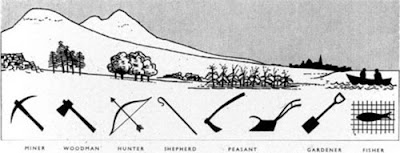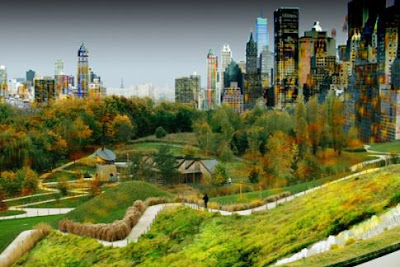Continuing the investigations of the introduction to the book ‘Ecological Urbanism‘ (read Part 1 here) – we pick up on the concepts of ecological urbanism in the explosion of interest in urban and local food production. Near and dear to my interests, the ability to transform such shrinking cities like Detroit, emulating the lessons and successes of places like Cuba who have created a new pattern of development based on necessity that is counter to the constant globalization we all deem necessary for progress.

:: Cuban Urban Agriculture – image via NEF
Mostafavi posits this could be a reaction to disasters such as Haiti, or the preceding national disaster in the Gulf: “One can also imagine that a city like New Orleans, devastated by Hurricane Katrina and and with little likelihood of major reconstruction any time soon, is ripe for such a project – for an urbanism that can address the vast areas of sparsely populated territory with productive and other forms of biologically diverse urban landscapes just as effectively as it can those areas still populated by a resilient community.” (p.39)
Agriculture isn’t typically considered in relation to ecology – aside from impacts, but again I think the definition in the book is for an ‘ecological approach’ versus the standard idea of ecology in pure environmental terms. Thus the idea for shrinking, or rapidly expanding urban areas to tackle the inputs and outputs of flows such as food and waste, using ecological metaphors, as a viable construct for an action-oriented ecological urbanism. This idea draws on and modernizes the regional concepts of Patrick Geddes, Lewis Mumford, and Benton MacKaye, and later revolutionary ecological ideas of Ian McHarg (who makes a cameo in the end of the book). The key is using our collective interdisciplinary intelligence to fill in some of the gaps in these earlier theories and apply them to a variety of global social and geographical situations.

:: Geddes‘ Valley Section – image via Goodspeed Update
Mostafavi gives an example of the resistance in African urban areas to top-down policies, requiring more integrated and ‘participatory’ methods that work in a range of cultural contexts. “Ecological urbanism must provide the necessary and emancipatory infrastructures for an alternative form of urbanism, on that brings together the benefits of both bottom-up and top-down approaches to urban planning.” (p.40)
The question, I guess, is how? It seems that flexibility is the key, with a radical change in fixed rules in cities to a more adaptable set of criteria to guide development (again hearkening back to LU theory) particularly when Western designers are operating in vastly different cultural circumstances (I’d throw in McDonough working in China as one example). Bateson’s ‘tightrope walker’ is a great one, with the idea of technique bolstered by repetition as an apt metaphor for ‘practice’.
:: Olympic Architecture in China – image via Chinese Architecture
And practice is at the heart of any concept, including Ecological Urbanism, to make it less of a theoretical construct and more of a guide for action that is called for early in this chapter. Two examples worthy of exploration: First the theory of Landscape Urbanism is a vibrant terrain forr changing the nature of static, fixed design which has been difficult to realize in built work – making in difficult if not impossible to provide a viable proof-of-concept. Conversely, New Urbanism contains a vibrant set of theories and rules, which have been broadly adapted, with most criticism leveled at the application, which often seems disconnected from what seem like good base principles. Appropriate theory and viable practice will be the touchstone for Ecological Urbanism to prove out (which I’m hoping is illuminated in the remaining essays of the text).
An example is the concept of developing Paris as a sustainable city, at the urging of French President Sarkozy. Instead of the traditional approach of planning, policy, then project – this concept flipped the tables by looking for projects. As Mostafavi concludes: “The early emphasis on projects rather than policies is a recognition of the value of projective possibilities for the physical development of the region. This type of speculative design is a necessary precondition for making radical policies that are embedded in imaginative and anticipatory forms of spatial practice.” (p.47)


:: Visions of Paris by Roland Castro – image via France 24
While it is unclear how this project in Paris will play out, the idea of the “…articulation of the interface, the liminal space, between the urban and the political,” (p.48) is at the heart of the idea of ecological urbanism within the context of this essay. Similar to the LU Theory, versus the ideas of the City Beautiful or New Urbanism mentioned previously, “…this approach does not rely on the image, nor on social homogeneity and nostalgia, as its primary sources of inspiration, but rather recognizes the importance of the urban as the necessary site of conflictual relations.” (p.48)
The idea of conflict is important as a referent to ecology, as it doesn’t describe a constructed, false ideology of community but one that is developed based on root instincts and flows of materials. This is embedded in an approach that includes ‘social and spatial democracy’ (p.50) that would be a result of this new approach. This is even more critical as we confront global economic uncertainty and continual emergence of man-caused ‘natural disasters’ which will influence larger numbers of people world-wide.” Mostafavi concludes:
“In this context, it is now up to use to develop the aesthetic means — the projects — that proposal alternative, inspiring, and ductile sensibilities for our ethico-political interactions with the environment. These projects will also provide the stage for the messiness, the unpredictability, and the instability of the urban, and in turn, for more just as well as more pleasurable futures. This is both the challenge and the promise of ecological urbanism.” (p.50)
So obviously one cannot make an assessment of the book based on the initial chapter, but I’m heartened by the approach implicit that frames the content, not as an ‘answer’ as much as a line of critical inquiry that builds on and frames previous explorations of landscape urbanism, ecological design, sustainable planning, and green design in a more interdisciplinary and flexible manner. Thus my take away was this isn’t necessarily to see a brave new theory (which was the case when initially reading about landscape urbanism). Rather this seems another name for an interdisciplinary consolidation (perhaps a necessary one) of multiple theories already happening in multivalent pathways.
One doesn’t come out with a feeling that ‘ecological urbanism‘ is the answer – much like many of the other ‘urbanisms‘ out there have a focus but not a broad inclusivity. Perhaps it’s the baggage of the term ‘ecological’ that confounds me (much as the baggage of the term ‘landscape’ shapes LU theory) – as it doesn’t seem a coherent enough idea to direct us in any particular direction. It does seem to be able to envelope and shape practice, but again it seems with enough supporting information, it would be easy to look at a range of projects within a lens of Ecological Urbanism, and connect some of the dots.
In summary, I am excited to dig into the rest of the volume (although it is daunting) to explore what ideas are contained within. While this seems a first step on a path towards urbanism that is more inclusive and equitable, this isn’t a roadmap. But it just may prove pivotal in changing the mindset of a broad spectrum of professionals and policy-makers, this is the dawn of a ‘new ethic s and aesthetics of the urban.’ Guess we shall see.
Endnote:
As I mentioned, I plan on tackling some of the other portions of the book in subsequent posts so look forward to subsequent posts loosely based on the sections of the book: Anticipate, Collaborate, Sense, Curate, Produce, Interact, Mobilize, Measure, Adapt, and Incubate… stay tuned.
There is the trend towards what I recently dubbed ‘Fill in the Blank’ Urbanism, which is spawned by a deep discussion of the nature and potential of Landscape Urbanism – and is a reaction to the myriad ‘urbanisms‘ that seem to pop up – so look forward to other investigations along these lines in addition to the ‘ecological’ – particularly two books I’m currently reading on the ‘integral’ and the ‘agricultural’ versions of this trend.
Also in the past few weeks, I was further tempted by a series of posts from the past couple of weeks on Urban Tick with a range of contributed posts on the book by Duncan Smith, Luis Suarez, DPR-Barcelona, Annick Labecca, Martin John Callanan, Stanza, Kiril Stanilov. I resisted reading the bulk of these until I got around to the book review – but was not disappointed. Check out the range of posts under the label Ecological Urbanism to get a wide reaction to the books content.
This books seems quite interesting; thanks for the recommendation.